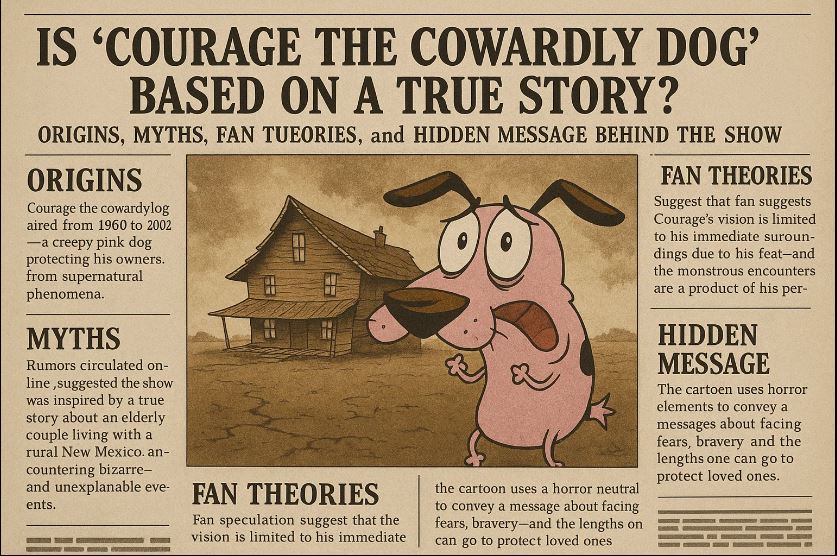
The big question that keeps floating around online: is Courage the Cowardly Dog based on a true story? The short answer is… sort of. Like any great urban legend, there’s a kernel of truth wrapped in layers of mystery, fan theories, and eerie coincidences. Today, let’s dig into the story of Courage, the myths that fuel its “true story” status, the deeper messages hidden in its madness, and why this pink pup still haunts our nostalgic hearts.
The Story of Courage the Cowardly Dog
Before we dive into the real-life rumors, let’s rewind.
Courage the Cowardly Dog ran from 1999 to 2002 on Cartoon Network, created by John R. Dilworth. The setup was deceptively simple:
Courage – a small pink dog who scares easily but always steps up to protect his owners.
Muriel Bagge – the sweet, loving Scottish woman who took Courage in.
Eustace Bagge – Muriel’s cranky, grumpy husband who constantly mocks Courage.
“Nowhere” – their isolated farmhouse setting, where all manner of supernatural and bizarre villains show up.
Each episode was essentially a mini horror movie disguised as a cartoon. Courage would face off against monsters, aliens, ghosts, demons, and some of the creepiest characters ever drawn. And while the animation was quirky, the tone leaned heavy on atmospheric dread, dark humor, and surreal imagery.
Kids didn’t know whether to laugh, scream, or both. That’s what made the show iconic.
Is Courage the Cowardly Dog Based on a True Story?
Here’s where things get interesting. Over the years, fans have linked the show to real-world stories. The most famous theory connects the Bagges’ farmhouse in Nowhere, Kansas to a very real place in New Mexico.
In Truth or Consequences, New Mexico, there once lived a reclusive elderly couple with their dog in a remote farmhouse. Local papers reported strange happenings, creepy neighbors, and unusual deaths in the area.
The house was surrounded by desert, eerily similar to the barren “Nowhere” in the show.
Some fans claim the couple and their dog were inspirations for Muriel, Eustace, and Courage.
Of course, creator John R. Dilworth has never confirmed this theory. But the visual similarities between the real house and the cartoon setting fueled the internet legend. It’s less “based on a true story” and more “loosely inspired by real vibes.”
Another layer comes from the Lovecraftian horror influence. Dilworth admitted he pulled from classic horror films, surrealism, and urban myths. That’s why some villains feel ripped from your nightmares. King Ramses, Katz, Freaky Fred, these weren’t just goofy antagonists; they were nightmare fuel.
So while Courage isn’t directly adapted from a specific true crime or horror story, the show’s DNA is stitched together from real-world influences, eerie coincidences, and universal childhood fears.
The Message Behind Courage the Cowardly Dog
Here’s the thing: under all the creepiness, Courage wasn’t just about jump scares. It carried some surprisingly heartfelt messages.
Fear and Bravery: Courage may have been terrified of everything, but he still faced his fears to protect Muriel. That’s the definition of true courage, being scared but doing it anyway.
Love and Loyalty: Muriel represented unconditional love. No matter what happened, she believed in Courage. That bond was the heart of the series.
Isolation: The Bagges lived “in the middle of Nowhere.” That isolation reflected feelings of loneliness, being misunderstood, and fighting battles nobody else sees.
Humanity’s Dark Side: Many villains weren’t supernatural but greedy, selfish humans. The show reminded us that real monsters aren’t always ghosts, they’re people.
For a cartoon aimed at kids, this was some heavy stuff. And yet, that’s why it connected so deeply. It spoke to fears we couldn’t always name.
Is There LGBTQ in Courage the Cowardly Dog?
This is one of the most debated fan theories. While the show never explicitly included LGBTQ storylines (this was late ’90s kids’ TV after all), some fans read between the lines.
Certain characters, like Katz with his flamboyant mannerisms, have been interpreted through a queer-coded lens.
Courage himself is often celebrated by LGBTQ fans as a symbol of “otherness”, he’s different, mocked, but ultimately a hero.
Themes of love, acceptance, and identity resonate strongly with LGBTQ audiences.
The creators never confirmed any of these interpretations, but like all good art, Courage the Cowardly Dog left enough ambiguity for audiences to find their own meaning.
Behind the Scenes: How Courage Became a Cult Classic
John R. Dilworth created Courage after his short film The Chicken from Outer Space gained attention. Cartoon Network saw the potential and greenlit a full series.
What made the show stand out?
Visual Style: A mix of hand-drawn animation, CGI, and surreal imagery. This hybrid gave the show its unsettling, dreamlike quality.
Villains: Characters like Freaky Fred (the barber obsessed with hair cutting) or King Ramses (with his iconic “Return the slab” chant) became legends of animated horror.
Tone: It never talked down to kids. Instead, it treated them as capable of handling fear, loss, and even mortality.
While it only ran for four seasons, the impact lasted far longer. To this day, fans trade stories of which episode scared them the most.
Fan Theories That Keep the Myth Alive
Beyond the “true story” farmhouse legend, fans have cooked up wild theories:
Courage is just imagining everything. The villains? Just strangers visiting the farmhouse, exaggerated through Courage’s anxious perspective.
Nowhere is purgatory. Muriel and Eustace are stuck in a limbo state, with Courage as their eternal guardian.
It’s about childhood trauma. Courage represents kids navigating a scary world without much protection, relying on their wits and resilience.
Are any of these confirmed? Nope. But that’s the beauty of it. The ambiguity keeps Courage alive in cultural memory.
Why Courage Still Matters Today
Two decades later, Courage remains one of Cartoon Network’s most daring experiments. It blended horror, comedy, and heartfelt emotion into a package that was as disturbing as it was endearing.
It showed kids that being scared doesn’t make you weak.
It reminded us that love can be a shield against life’s monsters.
And it left us with unforgettable imagery that’s still memed, discussed, and celebrated.
The “true story” may be more myth than fact, but the impact? That’s as real as it gets.
Conclusion: The Truth About Courage’s True Story
So, is Courage the Cowardly Dog a true story? Not exactly. It’s a surreal cartoon that drew inspiration from real-world loneliness, horror films, and urban legends. But thanks to creepy coincidences like the abandoned farmhouse in New Mexico, fans ran wild with theories that gave Courage an urban legend status of its own.
At the end of the day, Courage’s story isn’t about truth versus fiction, it’s about how a weird little pink dog showed us what courage really means: facing fear with love, loyalty, and heart.
And maybe that’s the scariest, and most beautiful, truth of all.

I am Jeremy Jahns – Your Cinematic Explorer
Immerse in movie reviews, Hollywood insights, and behind-the-scenes stories.